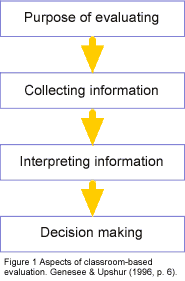Why Assess?
Meeting Needs of Various Stakeholders
 Genesee and Upshur (1996) write that the essential components of evaluation are purpose, information, interpretation, and decision making (see Figure 1). Our reasons for evaluating student learning will determine the kind of information we seek, how we collect it, how we interpret it, and how we use it to making decisions about future instruction.
Genesee and Upshur (1996) write that the essential components of evaluation are purpose, information, interpretation, and decision making (see Figure 1). Our reasons for evaluating student learning will determine the kind of information we seek, how we collect it, how we interpret it, and how we use it to making decisions about future instruction.
Teachers use assessments to:
- determine if learners have met the instructional objectives
- alter instructional approach as needed
- plan the next steps in instruction
- gather information for reporting purposes (grades),
- identify the appropriate level for a new student (placement),
- determine whether or not a student meets program requirements (certification),
- motivate learners to study and make steady progress.
Learners use assessments to:
- determine if they have met the instructional objectives of a course
- evaluate how well they are performing in a course
- indicate their strengths and weaknesses in knowledge and skills
- verify their self-evaluation of knowledge and skills
- set goals for future learning
Parents use assessments to:
- indicate what their child is learning in a course
- show the progress that their child is making in a course
- evaluate how well their child is achieving the course goals
School administrators use assessments to:
- determine if students receive credit for completing a course
- award special academic achievement honors to students
- report academic achievement to other schools, district offices, state departments of education
- hold students and teachers accountable for meeting local, state, national standards
- evaluate the effectiveness of instruction
Ultimately, assessments should be used collaboratively among the stakeholders to improve student learning.
